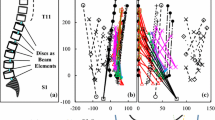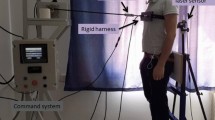Abstract
While viscoelastic responses of isolated trunk soft tissues have been characterized in earlier studies, the effects of external loading and flexion rate on these responses in the intact human trunk are largely unknown. Two experiments were conducted to measure trunk viscoelastic behaviors, one involving prolonged flexion with several extra loads (attached to the wrists) and the other repetitive trunk flexion with different extra loads and flexion rates. Direct outcome measures included initial trunk angle, creep angle, and residual/cumulative creep. Viscoelastic behaviors in both experiments were characterized using different Kelvin-solid models. For prolonged flexion, extra load significantly affected initial angle, creep angle, and viscoelastic model parameters, while residual creep remained unchanged. For repetitive flexion, cumulative creep angle significantly increased with both extra load and flexion rate. Nonlinear viscoelastic behavior of the trunk was evident in both experiments, which also indicated better predictive performance using Kelvin-solid models with ≥2 retardation time constants. Understanding trunk viscoelastic behaviors in response to flexion exposures can help in future modeling and in assessing how such exposures alter the synergy between active and passive trunk tissues.










Similar content being viewed by others
References
Adams, M., and P. Dolan. Recent advances and their clinical in lumbar spinal mechanics significance. Clin. Biomech. 10(1):3–19, 1995.
Arjmand, N., and A. Shirazi-Adl. Biomechanics of changes in lumbar posture in static lifting. Spine 30(23):2637–2648, 2005.
Bakker, E. W. P., A. P. Verhagen, E. Van Trijffel, C. Lucas, and B. W. Koes. Spinal mechanical load as a risk factor for low back pain: a systematic review of prospective cohort studies. Spine 34(8):E281–E293, 2009.
Bazrgari, B., B. Hendershot, K. Muslim, N. Toosizadeh, M. A. Nussbaum, and M. L. Madigan. Disturbance and recovery of trunk mechanical and neuromuscular behaviours following prolonged trunk flexion: influences of duration and external load on creep-induced effects. Ergonomics 54(11):1043–1052, 2011.
Bazrgari, B., A. Shirazi-Adl, and M. Kasra. Computation of trunk muscle forces, spinal loads and stability in whole-body vibration. J. Sound Vib. 318(4–5):1334–1347, 2008.
Brereton, L. C., and S. M. McGill. Effects of physical fatigue and cognitive challenges on the potential for low back injury. Hum. Mov. Sci. 18(6):839–857, 1999.
Brown, M. D., D. C. Holmes, A. D. Heiner, and K. F. Wehman. Intraoperative measurement of lumbar spine motion segment stiffness. Spine 27(9):954–958, 2002.
Burdorf, A., and G. Sorock. Positive and negative evidence of risk factors for back disorders. Scand. J. Work Environ. Health 23(4):243–256, 1997.
Burns, M., I. Kaleps, and L. Kazarian. Analysis of compressive creep behavior of the vertebral unit subjected to a uniform axial loading using exact parametric solution equations of Kelvin-solid models—Part I. Human intervertebral joints. J. Biomech. 17(2):113–115, 117–130, 1984.
De Leva, P. Adjustments to Zatsiorsky-Seluyanov’s segment inertia parameters. J. Biomech. 29(9):1223–1230, 1996.
Dolan, P., and M. Adams. Repetitive lifting tasks fatigue the back muscles and increase the bending moment acting on the lumbar spine. J. Biomech. 31(8):713–721, 1998.
Findley, W. N., J. S. Lai, and K. Onaran. Creep and Relaxation of Nonlinear Viscoelastic Materials: With an Introduction to Linear Viscoelasticity. Dover Publications, 1989.
Graham, R. B.and S. H. M. Brown. A direct comparison of spine rotational stiffness and dynamic spine stability during repetitive lifting tasks. J. Biomech. 2012.
Groth, K. M., and K. P. Granata. The viscoelastic standard nonlinear solid model: predicting the response of the lumbar intervertebral disk to low-frequency vibrations. J. Biomech. Eng. 130(031005), 2008.
Guan, Y., N. Yoganandan, J. Moore, F. A. Pintar, J. Zhang, D. J. Maiman, and P. Laud. Moment-rotation responses of the human lumbosacral spinal column. J. Biomech. 40(9):1975–1980, 2007.
Hawkins, D., C. Lum, D. Gaydos, and R. Dunning. Dynamic creep and pre-conditioning of the Achilles tendon in-vivo. J. Biomech. 42(16):2813–2817, 2009.
Hendershot, B., B. Bazrgari, K. Muslim, N. Toosizadeh, M. A. Nussbaum, and M. L. Madigan. Disturbance and recovery of trunk stiffness and reflexive muscle responses following prolonged trunk flexion: Influences of flexion angle and duration. Clin. Biomech. 26(3):250–256, 2011.
Hoogendoorn, W. E., P. M. Bongers, H. C. W. de Vet, M. Douwes, B. W. Koes, M. C. Miedema, G. A. M. Ariëns, and L. M. Bouter. Flexion and rotation of the trunk and lifting at work are risk factors for low back pain: results of a prospective cohort study. Spine 25(23):3087–3092, 2000.
Hult, E., L. Ekström, A. Kaigle, S. Holm, and T. Hansson. In vivo measurement of spinal column viscoelasticity—an animal model. Proc. Inst. Mech. Eng. H 209(2):105–110, 1995.
Keller, T. S., S. H. Holm, T. H. Hansson, and D. Spengler. The dependence of intervertebral disc mechanical properties on physiologic conditions. Spine 15(8):751–761, 1990.
Little, J. S., and P. S. Khalsa. Human lumbar spine creep during cyclic and static flexion: creep rate, biomechanics, and facet joint capsule strain. Ann. Biomed. Eng. 33(3):391–401, 2005.
Lu, D., P. Le, B. Davidson, B. H. Zhou, Y. Lu, V. Patel, and M. Solomonow. Frequency of cyclic lumbar loading is a risk factor for cumulative trauma disorder. Muscle Nerve 38(1):867–874, 2008.
Machiraju, C., A. V. Phan, A. Pearsall, and S. Madanagopal. Viscoelastic studies of human subscapularis tendon: relaxation test and a Wiechert model. Comput. Methods Programs Biomed. 83(1):29–33, 2006.
Magnusson, S. P., P. Aagaard, and J. J. Nielson. Passive energy return after repeated stretches of the hamstring muscle-tendon unit. Med. Sci. Sports Exerc. 32(6):1160–1164, 2000.
Marras, W. S., S. A. Lavender, S. Leurgans, S. Rajulu, W. G. Allread, F. A. Fathallah, and S. A. Ferguson. The role of dynamic three-dimensional trunk motion in occupationally-related low back disorders. Spine 18(5):617–628, 1993.
McGill, S., and S. Brown. Creep response of the lumbar spine to prolonged full flexion. Clin. Biomech. 7(1):43–46, 1992.
McGill, S., J. Seguin, and G. Bennett. Passive stiffness of the lumbar torso in flexion, extension, lateral bending, and axial rotation. Effect of belt wearing and breath holding. Spine 19(6):696–704, 1994.
Mital, A. Comprehensive maximum acceptable weight of lift database for regular 8-hour work shifts. Ergonomics 27(11):1127–1138, 1984.
Norman, R., R. Wells, P. Neumann, J. Frank, H. Shannon, and M. Kerr. A comparison of peak versus− cumulative physical work exposure risk factors for the reporting of low back pain in the automotive industry. Clin. Biomech. 13(8):561–573, 1998.
Nussbaum, M., and D. Chaffin. Development and evaluation of a scalable and deformable geometric model of the human torso. Clin. Biomech. 11(1):25–34, 1996.
Olson, M. W., Li L, and M. Solomonow. Interaction of viscoelastic tissue compliance with lumbar muscles during passive cyclic flexion–extension. J. Electromyogr. Kinesiol. 19(1):30–38, 2009.
Olson, M. W., L. Li, and M. Solomonow. Flexion-relaxation response to cyclic lumbar flexion. Clin. Biomech. 19(8):769–776, 2004.
Panjabi, M. M. The stabilizing system of the spine. Part I. Function, dysfunction, adaptation, and enhancement. J. Spinal Disord. 5:383–383, 1992.
Panjabi, M., T. Oxland, I. Yamamoto, and J. Crisco. Mechanical behavior of the human lumbar and lumbosacral spine as shown by three-dimensional load-displacement curves. J. Bone Joint Surg. Am. 76(3):413–424, 1994.
Parkinson, R. J., T. A. C. Beach, and J. P. Callaghan. The time-varying response of the in vivo lumbar spine to dynamic repetitive flexion. Clin. Biomech. 19(4):330–336, 2004.
Prado-Leon, L. R., A. Celis, and R. Avila-Chaurand. Occupational lifting tasks as a risk factor in low back pain: a case-control study in a Mexican population. Work 25(2):107–114, 2005.
Punnett, L., L. J. Fine, W. M. Keyserling, G. D. Herrin, and D. B. Chaffin. Back disorders and nonneutral trunk postures of automobile assembly workers. Scand. J. Work. Environ. Health 17(5):337–346, 1991.
Reeves, N. P., K. S. Narendra, and J. Cholewicki. Spine stability: the six blind men and the elephant. Clin. Biomech. 22(3):266–274, 2007.
Roy, S. H., C. J. De Luca, and D. A. Casavant. Lumbar muscle fatigue and chronic lower back pain. Spine 14(9):992, 1989.
Ryan, E., T. Herda, P. Costa, A. Walter, and J. Cramer. Dynamics of viscoelastic creep during repeated stretches. Scand. J. Med. Sci. Sports 22(2):179–184, 2011.
Shin, G., and C. D’Souza. EMG activity of low back extensor muscles during cyclic flexion/extension. J. Electromyogr. Kinesiol. 20(4):742–749, 2010.
Shin, G., C. D’Souza, and Y. H. Liu. Creep and fatigue development in the low back in static flexion. Spine 34(17):1873–1878, 2009.
Shin, G., and G. A. Mirka. An in vivo assessment of the low back response to prolonged flexion: interplay between active and passive tissues. Clin. Biomech. 22(9):965–971, 2007.
Snook, S. H., and V. M. Ciriello. The design of manual handling tasks: revised tables of maximum acceptable weights and forces. Ergonomics 34(9):1197–1213, 1991.
Solomonow, M. Neuromuscular manifestations of viscoelastic tissue degradation following high and low risk repetitive lumbar flexion. J. Electromyogr. Kinesiol. 22(2):155–175, 2011.
Solomonow, M., R. Baratta, B. H. Zhou, E. Burger, A. Zieske, and A. Gedalia. Muscular dysfunction elicited by creep of lumbar viscoelastic tissue. J. Electromyogr. Kinesiol. 13(4):381–396, 2003.
Toosizadeh, N., M. A. Nussbaum, B. Bazrgari, and M. L. Madigan. Load-relaxation properties of the human trunk in response to prolonged flexion: measuring and modeling the effect of flexion angle. PLoS ONE 7(11):e48625, 2012.
Troyer, K. L., and C. M. Puttlitz. Human cervical spine ligaments exhibit fully nonlinear viscoelastic behavior. Acta Biomater. 7(2):700–709, 2011.
Twomey, L., and J. Taylor. Flexion creep deformation and hysteresis in the lumbar vertebral column. Spine 7(2):116–122, 1982.
Yassierli, Y., M. A. Nussbaum, H. Iridiastadi, and L. A. Wojcik. The influence of age on isometric endurance and fatigue is muscle dependent: a study of shoulder abduction and torso extension. Ergonomics 50(1):26–45, 2007.
Youssef, J., B. Davidson, B. H. Zhou, Y. Lu, V. Patel, and M. Solomonow. Neuromuscular neutral zones response to static lumbar flexion: muscular stability compensator. Clin. Biomech. 23(7):870–880, 2008.
Acknowledgments
This work was supported by an award (R01 OH008504) from the Centers for Disease Control and Prevention (CDC). The contents are solely the responsibility of the authors and do not necessarily represent the official views of the CDC. The authors thank Mr. Waldron and Mr. Vest for their assembly and maintenance of the testing apparatus.
Conflict of interest statement
The authors have no conflict of interest.
Author information
Authors and Affiliations
Corresponding author
Additional information
Associate Editor Michael R. Torry oversaw the review of this article.
Rights and permissions
About this article
Cite this article
Toosizadeh, N., Nussbaum, M.A. Creep Deformation of the Human Trunk in Response to Prolonged and Repetitive Flexion: Measuring and Modeling the Effect of External Moment and Flexion Rate. Ann Biomed Eng 41, 1150–1161 (2013). https://doi.org/10.1007/s10439-013-0797-3
Received:
Accepted:
Published:
Issue Date:
DOI: https://doi.org/10.1007/s10439-013-0797-3




